
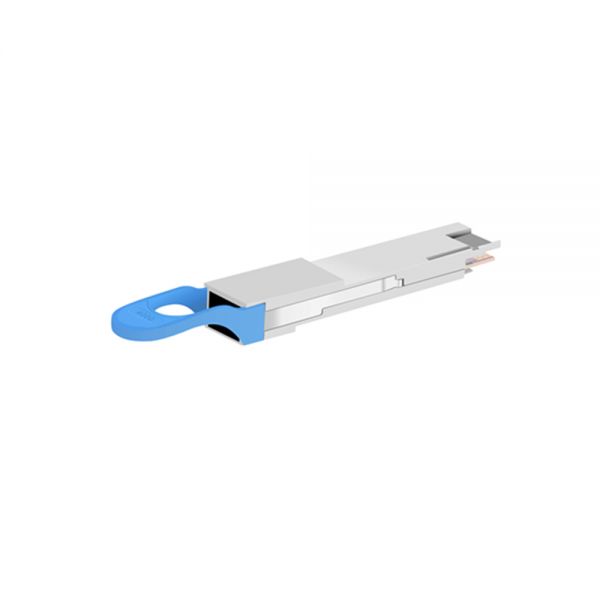
This product is a 400Gb/s Quad Small Form Factor Pluggable-double density (QSFP-DD) optical module designed for 500m optical communication applications.


This product is a 400Gb/s Quad Small Form Factor Pluggable-double density (QSFP-DD) optical module designed for 500m optical communication applications.
This product is a 400Gb/s Quad Small Form Factor Pluggable-double density (QSFP-DD) optical module designed for 500m optical communication applications. The module converts 8 channels of 50Gb/s (PAM4) electrical input data to 4 channels of parallel optical signals, each capable of 100Gb/s operation for an aggregate data rate of 400Gb/s. Reversely, on the receiver side, the module converts 4 channels of parallel optical signals of 100Gb/s each channel for an aggregate data rate of 400Gb/s into 8 channels of 50Gb/s (PAM4) electrical output data. An optical fiber cable with an MTP/MPO-12 connector can be plugged into the QSFP-DD DR4 module receptacle. Proper alignment is ensured by the guide pins inside the receptacle. The cable usually cannot be twisted for proper channel to channel alignment. Electrical connection is achieved through an QSFP-DD MSA-compliant edge type connector.
The product is designed with form factor, optical/electrical connection and digital diagnostic interface according to the QSFP-DD Multi-Source Agreement (MSA) Type 2. It has been designed to meet the harshest external operating conditions including temperature, humidity and EMI interference.
Functional Deion. The module incorporates 4 parallel channels on 1310nm center wavelength, operating at 100G per channel. The transmitter path incorporates a quad channel EML driver together with 4 parallel EMLs. On the receiver path, a PD array is connected with a quad channel TIA to convert the parallel 400Gb/s optical input into 4 channels of parallel 100Gb/s (PAM4) electrical signals. A DSP basis gearbox is used to convert 8 channels of 25GBaud PAM4 signals into 4 channels of 50GBaud PAM4 signals and also an 8-channel retimer and FEC block are integrated in this DSP. The electrical interface is compliant with IEEE 802.3bs and QSFP-DD MSA in the transmitting and receiving directions, and the optical interface is compliant to QSFP-DD MSA with MPO-12 connector.
A single +3.3V power supply is required to power up this product. All the power supply pins are internally connected and should be applied concurrently. As per MSA specifications the module offers seven low speed hardware control pins (including the 2-wire serial interface): ModSelL, SCL, SDA, ResetL, InitMode, ModPrsL and IntL. Module Select (ModSelL) is an input pin. When held low by the host, this product responds to 2-wire serial communication commands. The ModSelL allows the use of this product on a single 2-wire interface bus – individual ModSelL lines must be used. Serial Clock (SCL) and Serial Data (SDA) are required for the 2-wire serial bus communication interface and enable the host to access the memory map.
The ResetL pin enables a complete reset, returning the settings to their default state, when a low level on the ResetL pin is held for longer than the minimum pulse length. During the execution of a reset the host shall disregard all status bits until it indicates a completion of the reset interrupt. The product indicates this by posting an IntL (Interrupt) signal with the Data_Not_Ready bit negated in the memory map. Note that on power up (including hot ion) the module should post this completion of reset interrupt without requiring a reset. Initialize Mode (InitMode) is an input signal. It is pulled up to Vcc in the QSFP-DD module. The InitMode signal allows the host to define whether the QSFP-DD module will initialize under host software control (InitMode asserted High) or module hardware control (InitMode deasserted Low). Under host software control, the module shall remain in Low Power Mode until software enables the transition to High Power Mode, as defined in the QSFP-DD Management Interface Specification. Under hardware control (InitMode de-asserted Low), the module may immediately transition to High Power Mode after the management interface is initialized. The host shall not change the state of this signal while the module is present. In legacy QSFP applications, this signal is named LPMode. See SFF-8679 for LPMode signal deion. Module Present (ModPrsL) is a signal local to the host board which, in the absence of a product, is normally pulled up to the host Vcc. When the product is ed into the connector, it completes the path to ground through a resistor on the host board and asserts the signal. ModPrsL then indicates its present by setting ModPrsL to a “Low” state.
Interrupt (IntL) is an output pin. “Low” indicates a possible operational fault or a status critical to the host system. The host identifies the source of the interrupt using the 2-wire serial interface. The IntL pin is an open collector output and must be pulled to the Host Vcc voltage on the Host board.
Features
● QSFP-DD MSA compliant
● Parallel 4 Optical Lanes
● IEEE 802.3bs 400GBASE-DR4 Specification compliant
● Up to 500m transmission on single mode fiber (SMF) with FEC
● Operating case temperature: 0 to 70℃
● 8x53.125Gb/s electrical interface (400GAUI-8)
● Data Rate 106.25Gbps (PAM4) per channel
● Maximum power consumption 12W
● MPO-12 connector
● RoHS compliant
Transceiver Block Diagram
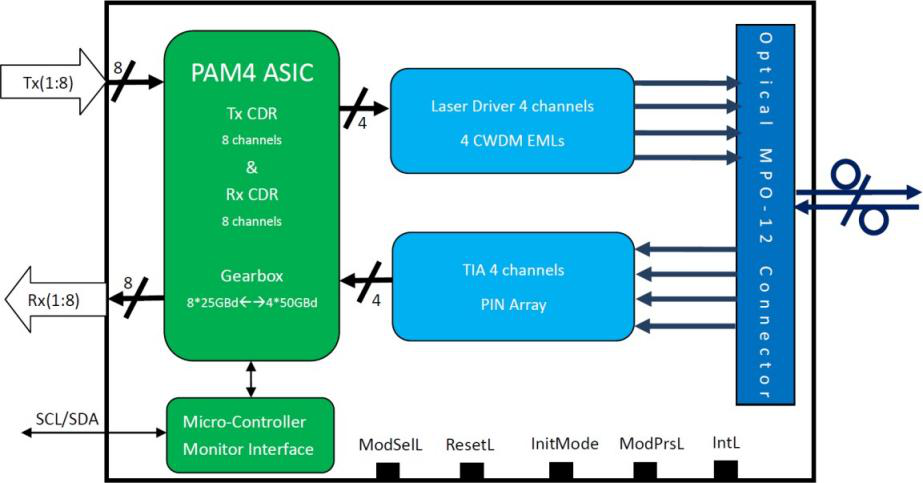
Figure 1. Transceiver Block Diagram
Pin Assignment and Description
The electrical pinout of the QSFP-DD module is shown in Figure 2 below.
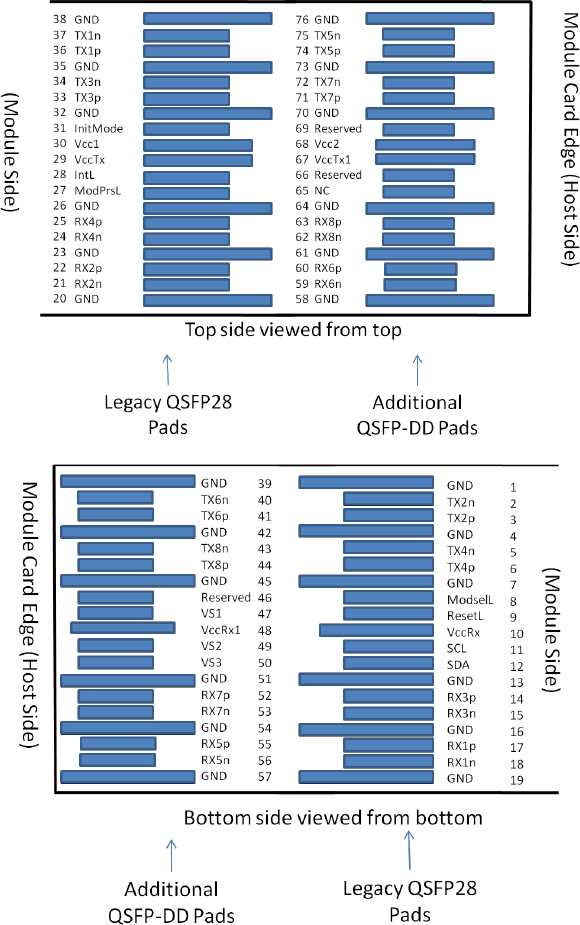
Figure 2. MSA Compliant Connector
Pin Definition
|
Pin # |
Logic |
Symbol |
Deion |
Plug Sequence |
|
1 |
|
GND |
Ground |
1B |
|
2 |
CML-I |
Tx2n |
Transmitter Inverted Data Input |
3B |
|
3 |
CML-I |
Tx2p |
Transmitter Non-Inverted Data Input |
3B |
|
4 |
|
GND |
Ground |
1B |
|
5 |
CML-I |
Tx4n |
Transmitter Inverted Data Input |
3B |
|
6 |
CML-I |
Tx4p |
Transmitter Non-Inverted Data Input |
3B |
|
7 |
|
GND |
Ground |
1B |
|
8 |
LVTTL-I |
ModSelL |
Module Select |
3B |
|
9 |
LVTTL-I |
ResetL |
Module Reset |
3B |
|
10 |
|
VccRx |
+3.3V Power Supply Receiver |
2B |
|
11 |
LVCMOS-I/O |
SCL |
2-wire serial interface clock |
3B |
|
12 |
LVCMOS-I/O |
SDA |
2-wire serial interface data |
3B |
|
13 |
|
GND |
Ground |
1B |
|
14 |
CML-O |
Rx3p |
Receiver Non-Inverted Data Output |
3B |
|
15 |
CML-O |
Rx3n |
Receiver Inverted Data Output |
3B |
|
16 |
GND |
Ground |
1B |
|
|
17 |
CML-O |
Rx1p |
Receiver Non-Inverted Data Output |
3B |
|
18 |
CML-O |
Rx1n |
Receiver Inverted Data Output |
3B |
|
19 |
|
GND |
Ground |
1B |
|
20 |
|
GND |
Ground |
1B |
|
21 |
CML-O |
Rx2n |
Receiver Inverted Data Output |
3B |
|
22 |
CML-O |
Rx2p |
Receiver Non-Inverted Data Output |
3B |
|
23 |
|
GND |
Ground |
1B |
|
24 |
CML-O |
Rx4n |
Receiver Inverted Data Output |
3B |
|
25 |
CML-O |
Rx4p |
Receiver Non-Inverted Data Output |
3B |
|
26 |
|
GND |
Ground |
1B |
|
27 |
LVTTL-O |
ModPrsL |
Module Present |
3B |
|
28 |
LVTTL-O |
IntL |
Interrupt |
3B |
|
29 |
|
VccTx |
+3.3V Power supply transmitter |
2B |
|
30 |
|
Vcc1 |
+3.3V Power supply |
2B |
|
31 |
LVTTL-I |
InitMode |
Initialization mode; In legacy QSFP applications, the InitMode pad is called LPMODE |
3B |
|
32 |
|
GND |
Ground |
1B |
|
33 |
CML-I |
Tx3p |
Transmitter Non-Inverted Data Input |
3B |
|
34 |
CML-I |
Tx3n |
Transmitter Inverted Data Input |
3B |
|
35 |
|
GND |
Ground |
1B |
|
36 |
CML-I |
Tx1p |
Transmitter Non-Inverted Data Input |
3B |
|
37 |
CML-I |
Tx1n |
Transmitter Inverted Data Input |
3B |
|
38 |
|
GND |
Ground |
1B |
|
39 |
|
GND |
Ground |
1A |
|
40 |
CML-I |
Tx6n |
Transmitter Inverted Data Input |
3A |
|
41 |
CML-I |
Tx6p |
Transmitter Non-Inverted Data Input |
3A |
|
42 |
|
GND |
Ground |
1A |
|
43 |
CML-I |
Tx8n |
Transmitter Inverted Data Input |
3A |
|
44 |
CML-I |
Tx8p |
Transmitter Non-Inverted Data Input |
3A |
|
45 |
|
GND |
Ground |
1A |
|
46 |
|
Reserved |
For future use |
3A |
|
47 |
|
VS1 |
Module Vendor Specific 1 |
3A |
|
48 |
|
VccRx1 |
3.3V Power Supply |
2A |
|
49 |
|
VS2 |
Module Vendor Specific 2 |
3A |
|
50 |
|
VS3 |
Module Vendor Specific 3 |
3A |
|
51 |
|
GND |
Ground |
1A |
|
52 |
CML-O |
Rx7p |
Receiver Non-Inverted Data Output |
3A |
|
53 |
CML-O |
Rx7n |
Receiver Inverted Data Output |
3A |
|
54 |
|
GND |
Ground |
1A |
|
55 |
CML-O |
Rx5p |
Receiver Non-Inverted Data Output |
3A |
|
56 |
CML-O |
Rx5n |
Receiver Inverted Data Output |
3A |
|
57 |
|
GND |
Ground |
1A |
|
58 |
|
GND |
Ground |
1A |
|
59 |
CML-O |
Rx6n |
Receiver Inverted Data Output |
3A |
|
60 |
CML-O |
Rx6p |
Receiver Non-Inverted Data Output |
3A |
|
61 |
|
GND |
Ground |
1A |
|
62 |
CML-O |
Rx8n |
Receiver Inverted Data Output |
3A |
|
63 |
CML-O |
Rx8p |
Receiver Non-Inverted Data Output |
3A |
|
64 |
|
GND |
Ground |
1A |
|
65 |
|
NC |
No Connect |
3A |
|
66 |
|
Reserved |
For future use |
3A |
|
67 |
|
VccTx1 |
3.3V Power Supply |
2A |
|
68 |
|
Vcc2 |
3.3V Power Supply |
2A |
|
69 |
|
Reserved |
For Future Use |
3A |
|
70 |
|
GND |
Ground |
1A |
|
71 |
CML-I |
Tx7p |
Transmitter Non-Inverted Data Input |
3A |
|
72 |
CML-I |
Tx7n |
Transmitter Inverted Data Input |
3A |
|
73 |
|
GND |
Ground |
1A |
|
74 |
CML-I |
Tx5p |
Transmitter Non-Inverted Data Input |
3A |
|
75 |
CML-I |
Tx5n |
Transmitter Inverted Data Input |
3A |
|
76 |
|
GND |
Ground |
1A |
Recommended Power Supply Filter
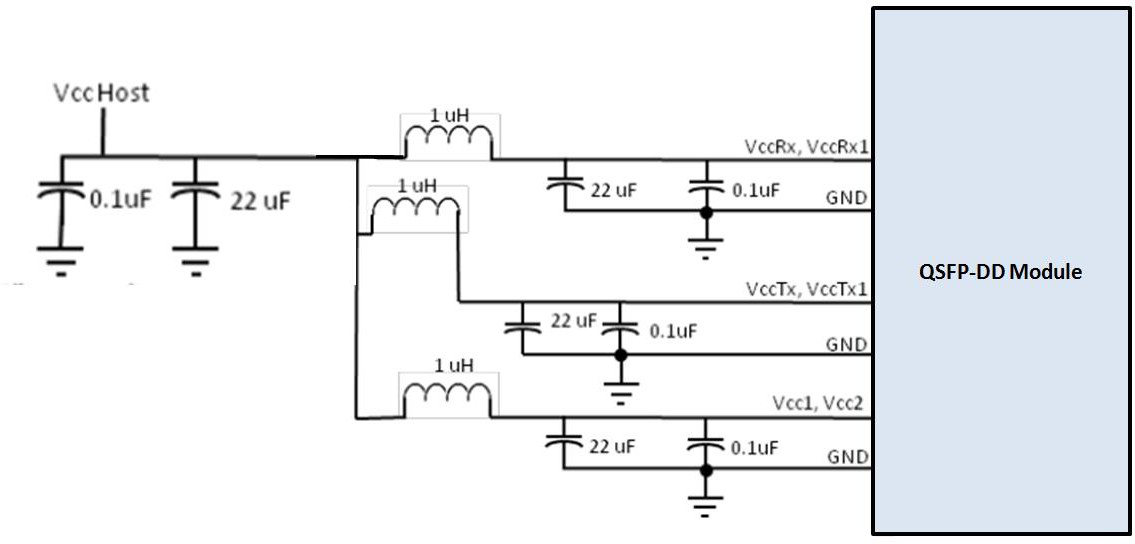
Figure 3. Recommended Power Supply Filter
Absolute Maximum Ratings
It has to be noted that the operation in excess of any individual absolute maximum ratings might cause permanent damage to this module.
|
Parameter |
Symbol |
Min |
Max |
Units |
Notes |
|
Storage Temperature |
TS |
-40 |
85 |
degC |
|
|
Operating Case Temperature |
TOP |
0 |
70 |
degC |
|
|
Power Supply Voltage |
VCC |
-0.5 |
3.6 |
V |
|
|
Relative Humidity (non-condensation) |
RH |
0 |
85 |
% |
|
|
Damage Threshold, each Lane |
THd |
5 |
|
dBm |
|
Recommended Operating Conditions and Power Supply Requirements
|
Parameter |
Symbol |
Min |
Typical |
Max |
Units |
Notes |
|
Operating Case Temperature |
TOP |
0 |
|
70 |
degC |
|
|
Power Supply Voltage |
VCC |
3.135 |
3.3 |
3.465 |
V |
|
|
Data Rate, each Lane |
|
|
26.5625 |
|
GBd |
PAM4 |
|
Data Rate Accuracy |
|
-100 |
|
100 |
ppm |
|
|
Pre-FEC Bit Error Ratio |
|
|
|
2.4x10-4 |
|
|
|
Post-FEC Bit Error Ratio |
|
|
|
1x10-12 |
|
1 |
|
Link Distance |
D |
2 |
|
500 |
m |
2 |
Notes:
FEC provided by host system.
FEC required on host system to support maximum distance.
Electrical Characteristics
The following electrical acteristics are defined over the Recommended Operating Environment unless otherwise specified.
|
Parameter |
Test Point |
Min |
Typical |
Max |
Units |
Notes |
|
Power Consumption |
|
|
|
12 |
W |
|
|
Supply Current |
Icc |
|
|
3.64 |
A |
|
|
Transmitter (each Lane) |
||||||
|
Signaling Rate, each Lane |
TP1 |
26.5625 ± 100 ppm |
GBd |
|
||
|
Differential pk-pk Input Voltage Tolerance |
TP1a |
900 |
|
|
mVpp |
1 |
|
Differential Termination Mismatch |
TP1 |
|
|
10 |
% |
|
|
Differential Input Return Loss |
TP1 |
IEEE 802.3-
2015
Equation
(83E-5) |
|
|
dB
|
|
|
Differential to Common
Mode Input Return Loss
|
TP1 |
IEEE 802.3-
2015
Equation
(83E-6) |
|
|
dB |
|
|
Module Stressed Input Test |
TP1a |
See IEEE 802.3bs 120E.3.4.1 |
|
2 |
||
|
Single-ended Voltage Tolerance Range (Min) |
TP1a |
-0.4 to 3.3 |
V |
|
||
|
DC Common Mode Input Voltage |
TP1 |
-350 |
|
2850 |
mV |
3 |
|
Receiver (each Lane) |
||||||
|
Signaling Rate, each lane |
TP4 |
26.5625 ± 100 ppm |
GBd |
|
||
|
Differential Peak-to-Peak Output Voltage |
TP4 |
|
|
900 |
mVpp |
|
|
AC Common Mode Output Voltage, RMS |
TP4 |
|
|
17.5 |
mV |
|
|
Differential Termination Mismatch |
TP4 |
|
|
10 |
% |
|
|
Differential Output Return Loss |
TP4 |
IEEE 802.3-
2015
Equation
(83E-2) |
|
|
|
|
|
Common to Differential Mode Conversion Return Loss |
TP4 |
IEEE 802.3-
2015
Equation
(83E-3) |
|
|
|
|
|
Transition Time, 20% to 80% |
TP4 |
9.5 |
|
|
Ps |
|
|
Near-end Eye Symmetry Mask Width (ESMW) |
TP4 |
|
0.265 |
|
UI |
|
|
Near-end Eye Height, Differential |
TP4 |
70 |
|
|
mV |
|
|
Far-end Eye Symmetry Mask Width (ESMW) |
TP4 |
|
0.2 |
|
UI |
|
|
Far-end Eye Height, Differential |
TP4 |
30 |
|
|
mV |
|
|
Far-end Pre-cursor ISI Ratio |
TP4 |
-4.5 |
|
2.5 |
% |
|
|
Common Mode Output Voltage (Vcm) |
TP4 |
-350 |
|
2850 |
mV |
3 |
Notes:
With the exception to IEEE 802.3bs 120E.3.1.2 that the pattern is PRBS31Q or scrambled idle.
Meets BER specified in IEEE 802.3bs 120E.1.1.
DC common mode voltage generated by the host. Specification includes effects of ground offset voltage.
Optical Characteristics
|
Parameter |
Symbol |
Min |
Typical |
Max |
Units |
Notes |
|
Center Wavelength |
λc |
1304.5 |
1310 |
1317.5 |
nm |
|
|
Transmitter |
||||||
|
Data Rate, each Lane |
|
53.125 ± 100 ppm |
GBd |
|
||
|
Modulation Format |
|
PAM4 |
|
|
||
|
Side-mode Suppression Ratio |
SMSR |
30 |
|
|
dB |
|
|
Average Launch Power, each Lane |
PAVG |
-2.9 |
|
4 |
dBm |
1 |
|
Outer Optical Modulation Amplitude (OMAouter), each Lane |
POMA |
-0.8 |
|
4.2 |
dBm |
2 |
|
Launch Power in OMAouter minus TDECQ), each Lane
for ER ≥ 5dB
for ER < 5dB |
|
-2.2
-1.9 |
|
|
dB |
|
|
Transmitter and Dispersion Eye Closure for PAM4, each Lane |
TDECQ |
|
|
3.4 |
dB |
|
|
TDECQ – 10*log10(Ceq), each Lane |
|
|
|
3.4 |
dB |
3 |
|
Extinction Ratio |
ER |
3.5 |
|
|
dB |
|
|
RIN21.4OMA |
RIN |
|
|
–136 |
dB/Hz |
|
|
Optical Return Loss Tolerance |
TOL |
|
|
21.4 |
dB |
|
|
Transmitter Reflectance |
TR |
|
|
-26 |
dB |
|
|
Transmitter Transition Time |
|
|
|
17 |
ps |
|
|
Average Launch Power of OFF Transmitter, each Lane |
Poff |
|
|
-15 |
dBm |
|
|
Receiver |
||||||
|
Data Rate, each Lane |
|
53.125 ± 100 ppm |
GBd |
|
||
|
Modulation Format |
|
PAM4 |
|
|
||
|
Damage Threshold, each Lane |
THd |
5 |
|
|
dBm |
4 |
|
Average Receive Power, each Lane |
|
-5.9 |
|
4 |
dBm |
5 |
|
Receive Power (OMAouter), each Lane |
|
|
|
4.2 |
dBm |
|
|
Receiver Sensitivity (OMAouter), each Lane |
SEN |
|
|
Equation (1) |
dBm |
6 |
|
Stressed Receiver Sensitivity (OMAouter), each Lane |
SRS |
|
|
-1.9 |
dBm |
7 |
|
Receiver Reflectance |
RR |
|
|
-26 |
dB |
|
|
LOS Assert |
LOSA |
-15 |
|
|
dBm |
|
|
LOS De-assert |
LOSD |
|
|
-8.9 |
dBm |
|
|
LOS Hysteresis |
LOSH |
0.5 |
|
|
dB |
|
|
Stressed Conditions for Stress Receiver Sensitivity (Note 8) |
||||||
|
Stressed Eye Closure for PAM4 (SECQ), Lane under Test |
|
|
3.4 |
|
dB |
|
|
SECQ – 10*log10(Ceq), Lane under Test |
|
|
|
3.4 |
dB |
|
|
OMAouter of each Aggressor Lane |
|
|
4.2 |
|
dBm |
|
Notes:
1. Average launch power, each lane (min) is informative and not the principal indicator of signal strength. A transmitter with launch power below this value cannot be compliant; however, a value above this does not ensure compliance.
2. Even if the TDECQ < 1.4dB for an extinction ratio of ≥ 5dB or TDECQ < 1.1dB for an extinction ratio of < 5dB, the OMAouter (min) must exceed the minimum value specified here.
3. Ceq is a coefficient defined in IEEE Std 802.3-2018 clause 121.8.5.3 which accounts for reference equalizer noise enhancement.
4. Average receive power, each lane (min) is informative and not the principal indicator of signal strength. A received power below this value cannot be compliant; however, a value above this does not ensure compliance.
5. The receiver shall be able to tolerate, without damage, continuous exposure to a modulated optical input signal having this power level on one lane. The receiver does not have to operate correctly at this input power.
6. Receiver sensitivity (OMAouter), each lane (max) is informative and is defined for a transmitter with a value of SECQ up to 3.4 dB. It should meet Equation (1), which is illustrated in Figure 4.
Where:
RS is the receiver sensitivity, and
SECQ is the SECQ of the transmitter used to measure the receiver sensitivity.
7. Measured with conformance test signal at TP3 for the BER equal to 2.4x10-4.
8.These test conditions are for measuring stressed receiver sensitivity. They are not acteristics of the receiver.
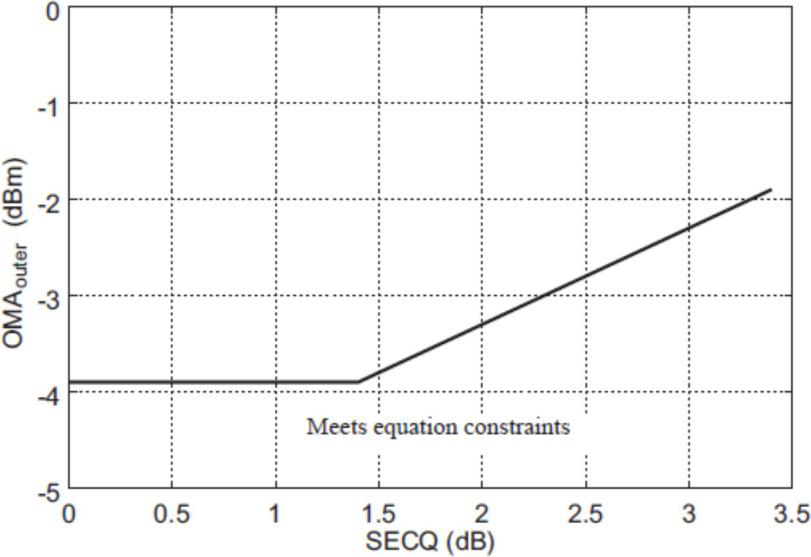
Figure 4. Illustration of Receiver Sensitivity Mask for 400G-DR4
Digital Diagnostic Functions
The following digital diagnostic acteristics are defined over the normal operating conditions unless otherwise specified.
|
Parameter |
Symbol |
Min |
Max |
Units |
Notes |
|
Temperature Monitor Absolute Error |
DMI_Temp |
-3 |
3 |
degC |
Over operating temperature range |
|
Supply Voltage Monitor
Absolute Error |
DMI _VCC |
-0.1 |
0.1 |
V |
Over full operating
range |
|
Channel RX Power Monitor Absolute Error |
DMI_RX_Ch |
-2 |
2 |
dB |
1 |
|
Channel Bias Current
Monitor |
DMI_Ibias_Ch |
-10% |
10% |
mA |
|
|
Channel TX Power Monitor
Absolute Error |
DMI_TX_Ch |
-2 |
2 |
dB |
1 |
Notes:
Due to measurement accuracy of different single mode fibers, there could be an additional +/-1 dB fluctuation, or a +/- 3 dB total accuracy.
Outline Drawing (mm)
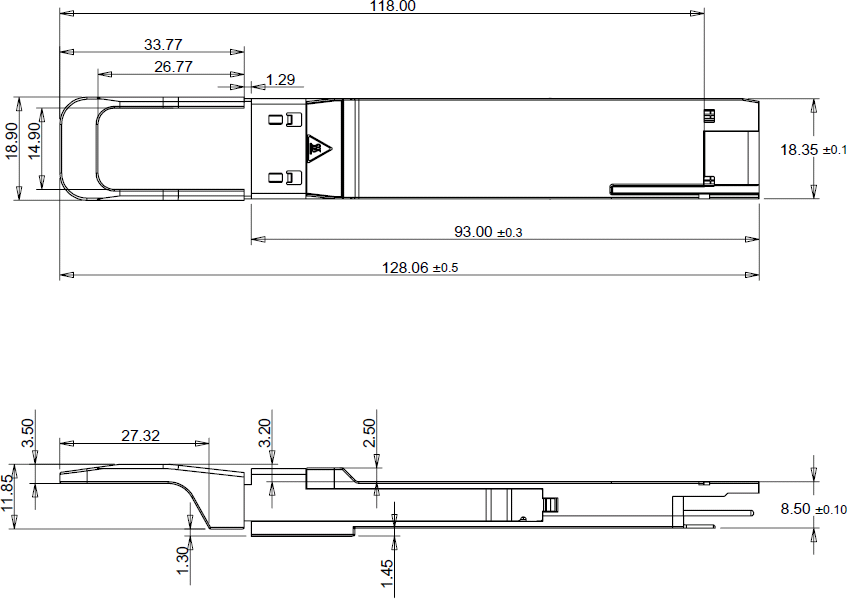
ESD
This transceiver is specified as ESD threshold 1kV for high-speed data pins and 2kV for all other electrical input pins, tested per MIL-STD-883, Method 3015.4 /JESD22-A114-A (HBM). However, normal ESD precautions are still required during the handling of this module. This transceiver is shipped in ESD protective packaging. It should be removed from the packaging and handled only in an ESD protected environment.
Laser Safety
This is a Class 1 Laser Product according to EN 60825-1:2014. This product complies with 21 CFR 1040.10 and 1040.11 except for deviations pursuant to Laser Notice No. 50, dated (June 24, 2007).
Caution: Use of controls or adjustments or performance of procedures other than those specified herein may result in hazardous radiation exposure.
Applications
● 400G Ethernet
● InfiniBand interconnects
| Ordering Information |
|---|
| Date | Version | Description | Download |
|---|---|---|---|
| 2024-04-28 | V1.0 | Datasheet_400G QSFP-DD DR4 1310nm 500m_LA-OT-400G-DR4 | |
| Photo | Model | Description |
|---|